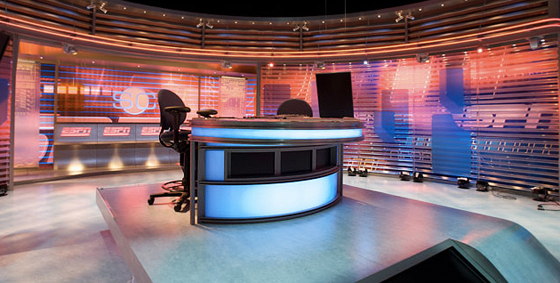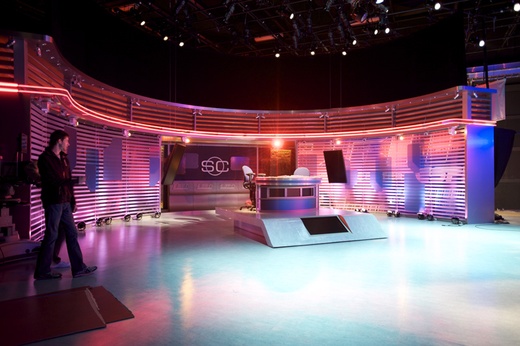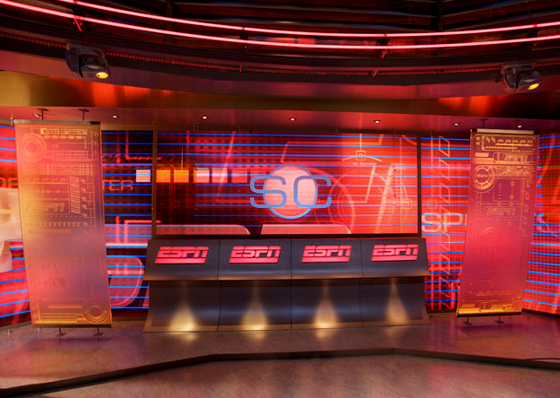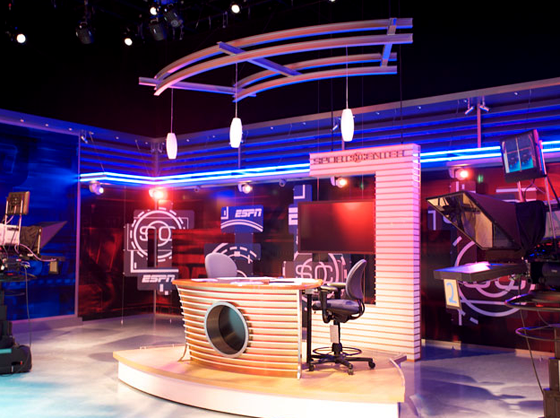Fabricating a Design: Designing the newest ESPN set
Weekly insights on the technology, production and business decisions shaping media and broadcast. No paywall. Independent coverage. Unsubscribe anytime.

NewscastStudio regularly gives a bird’s eye view of various broadcast sets, but never before have we taken a look at how the role of the fabricator fits into the world of the designer. This exclusive series goes behind the scenes of ESPN’s latest set and shows you how Jack Morton PDG and Lexington Design + Fabrication work together to create innovative sets.
This is the second of a three-part interview by NewscastStudio, with both the designer and the fabricator of ESPN’s new SportsCenter Los Angeles set.
Andre Durette is VP/Senior Design Director at Jack Morton PDG in New York City, an award-winning broadcast environment design firm that is part of Jack Morton Worldwide, the global experiential marketing agency. Jack Morton PDG is the firm behind many of the sets for ESPN for which they used Lexington Design + Fabrication.
Ron Hubbard is the general manager and vice president of Production at Lexington Design + Fabrication, an award-winning Los Angeles-based design-build firm for themed environments.

Photo by Steven Barry/ESPN
NewscastStudio: Last interview, you gave us a general overview of how you two work together — the fabricator’s role working with the designer. Now let’s talk more specifically about the newest ESPN set, SportsCenter LA.
Andre Durette: ESPN’s new set opened with lively ceremony right downstairs from the studio, on the LA Live plaza, complete with the University of Southern California Marching Band. Kobe Bryant opened with his own rendition of the SportsCenter sign-on — “Wassup? This is Kobe Bryant and you’re watching SportsCenter Los Angeles.” And that marked the first time SportsCenter has ever broadcast from anywhere in America other than Bristol, Conn.
NS: Why did ESPN decide to build a second SportsCenter broadcast location at all?
AD: Well, the why has a lot to do with the where. ESPN wanted to have a significant presence on the West Coast, for geographic diversity as they grow.
Ron Hubbard: And being here in L.A., the entertainment capital, and right across from Staples Center, it gives them terrific access for interviews with sports stars and other celebrities before and after games. Also, the ESPN production team that’s doing the 1 a.m. Eastern Time edition of SportsCenter, is now on the West Coast producing it at 10 p.m. Pacific Time. So now this team is fresh, not having to work into the wee hours of the morning, as they did when this edition was produced in Bristol.

ESPN ‘SportsCenter’ Los Angeles set
NS: What were ESPN’s goals and needs for the design of the Los Angeles set?
AD: ESPN’s Senior Creative Director Noubar Stone, gave us a lot of guidance and made his vision clear. He asked us to create a duplicate of the Bristol set, as the plan was to connect the two studios technologically so they could switch back and forth between the two seamlessly. This would give the viewers the feeling that they were basically in the same place — at SportsCenter.
RH: As the process developed, we realized we could get close, but we could not produce an exact duplicate of Bristol.
NS: What stopped that from happening?
RH: We had budget constraints, and much less space than the Bristol set has — less than half the space. While the facility is 12,300 square feet, that has to fit five control rooms, eight editing suites, the radio station rooms, the SportsCenter set and room for another set to be built in the future.
NS: What was is like for you to go back and look at the Bristol set, knowing that you have to fit that into that much less space?
AD: Actually, there was no time for us to fly to Bristol to revisit the old set. But we had all the blueprints from when we designed it, and we knew the look of the set very well anyway.
NS: How long was your build time for Los Angeles?
AD: Three months. So we had the constraints of less time, budget and space. All this made us rethink the entire project. And we came up with solutions that would evoke the same presence as Bristol, but we used different materials and techniques. And the changes are so subtle that very few people would actually notice a difference on screen.

ESPN ‘SportsCenter’ Los Angeles set
NS: What are some examples of those differences?
AD: For one thing, the Bristol studio floor is a printed graphic that Jack Morton PDG designed. But it was impossible to recreate it exactly in L.A. on such a short timetable. So we searched and found a product that resembled the hue of the floor in Bristol. And with lighting, we figured out how we could retain the same idea.
RH: The L.A. studio floor is an example of how sometimes the materials we found were surprisingly better than on the Bristol set, as technology has advanced so much. We built that floor with a great looking tile called Amtico, which is eco-friendly and very durable.
NS: It’s definitely hard to see a difference in the two floors, but the overall colors of the L.A. studio seem a little more vivid than Bristol.
AD: Yes, it’s not easily perceptible, but the louvers behind the L.A. anchors are different. We put frosted, angled acrylic louvers behind them. In Bristol, those louvers are completely horizontal, and clear, not frosted. The frosted angled louvers interact with the LED lighting differently – making the colors more vibrant.
NS: How did you deal with downsizing everything for L.A. while still giving the same feeling as the Bristol set on the air?
AD: We had to be very clever. For example, we shortened the top aluminum louvers quite a bit. We also did away with the floating logo above due to no space to fly the sign in.

ESPN ‘SportsCenter’ Los Angeles set
NS: Did the fact that the studio is on the third floor of the building present any challenges to your design?
AD: Not in the design itself, but it was definitely a challenge for Lexington in delivering the set pieces, right Ron?
RD: Yes, that was a delivery we will not soon forget. We knew the set elements wouldn’t fit in the elevator and we knew we’d have to send them up through the third floor doors with a crane that was built into the building. No surprises there. But the biggest challenge was to not hit the glass canopy that surrounds the ESPN Zone restaurant below. And due to all the craziness of the completion of the entire L.A. Live site at the time, we had to start doing our crane lifts at 3 a.m., to be out of any of the public areas and totally out of sight by 10 a.m.
AD: Hopefully when we deliver the second studio, there won’t be any conflicting events to work around like that. But with Staples Center, the Nokia Theater and the Grammy Museum all right there, what are the chances of nothing happening there on any given day?
NS: Any word on which ESPN set you’ll be putting into that second studio? Is it a new show?
AD: ESPN is keeping that under tight wraps for now. We’ll keep you posted though.

ESPN ‘SportsCenter’ Los Angeles set
NS: Speaking of secrets, in our first interview, we briefly discussed all those shades of amber on the sets with LED lights.
AD: Yes, I did get the go ahead to share more details of that with you. As I said before, our clients tend to love amber, so we wanted to create a lot of different shades. The problem wasn’t that amber doesn’t exist. It does in RGB-A fixtures. The “A” stands for amber, and it reacts with the other colors to produce a variety of shades. The problem was that those RGB-A fixtures are way too bulky for what we need — they’re about 4 inches by 6 inches by 3. But we like to put lights in all kinds of small places, like in columns and in desks.
NS: We see a lot of those lighted details on your sets.
AD: And they need to be very small profile, more like half an inch by half an inch each. And those very small LED fixtures come in bands of RGB and in amber, but separately. So we take a row of each and alternate them to fill the unit. So again, the amber reacts with the other colors.
The secret to making all kinds of great shades with these pairings of tiny fixtures — it’s all in the testing. Starting back when we did the ESPN News set with Lexington, we began doing lots of tests of the lighting on camera, in order to make the lights diffuse just the way we need, to get the shades we want. Every material reacts to light differently – some create pastels and some create rich, saturated colors. The same lights will react differently in different columns on the set, depending on what kind of plexiglas they are made of, how thick it is and if the Plexi itself has a tint to it. Those same lights will also produce different shades if they’re in the edge of a desk. For each place we put a light fixture, we have to come up with a different solution for getting the various shades of light we want. So together with our lighting designer, Bruce Ferri, the Lexington team and the Jack Morton PDG team — we do a lot of testing.
Part three in our series Fabricating a Design goes deeper into the new ESPN ‘SportsCenter’ Lost Angeles set.






tags
Andre Durette, ESPN, espn la, Jack Morton Worldwide, lexington design + fabrication, SportsCenter, sportscenter la
categories
Exclusives, Fabrication, Set Design